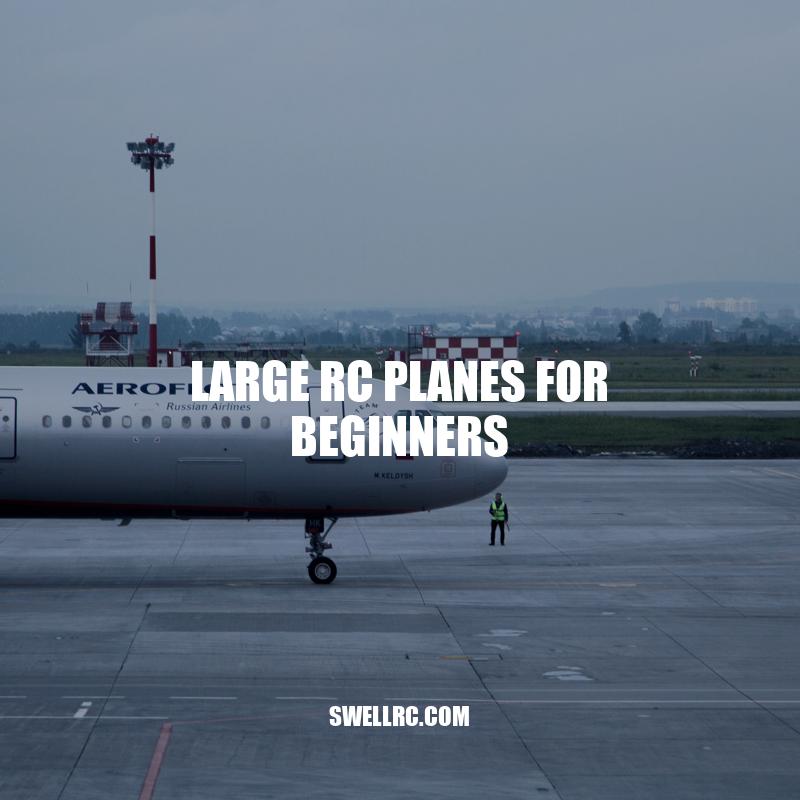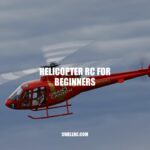Beginner’s Guide to Large RC Planes: Tips, Tricks and Top Picks
Remote controlled (RC) planes have become increasingly popular over the years, with many hobbyists displaying their collections at various events and competitions. While there are many types and sizes of RC planes to choose from, large RC planes have gained popularity among beginners for a few good reasons. They are easier to see in the sky than smaller planes, and their larger size makes them more stable, which can help novice pilots feel more confident as they learn to fly. There are several things that beginners need to take into consideration before buying a large RC plane, including important features, factors such as different types of planes and budgets, and tips for safely and effectively operating the planes. In this article, we’ll take a closer look at large RC planes for beginners, including what to look for when making a purchase, tips for getting started, and recommendations for some of the best large RC planes for beginners.
Large RC planes for beginners are models designed with novice pilots in mind. These planes are typically larger in size than those used by intermediate or advanced pilots. Generally, a large RC plane for beginners will have a wingspan of at least 48 inches and a weight of around 3 to 6 pounds. Some features of large RC planes for beginners could include:
- Durable materials such as foam or fiberglass that can withstand rough landings or crashes easily.
- A user-friendly design that is easy to assemble and operate.
- A stable and dependable flight pattern that can help new pilots learn to control the plane
- An electric motor powered by a rechargeable battery, which is quieter and easier to maintain than gas-powered planes.
- A remote control that is intuitive and easy to use for new pilots.
When looking for a large RC plane for beginners, it’s important to keep these factors in mind. Several sites offer a wide range of RC planes for beginners, such as Horizon Hobby, Tower Hobbies, Motion RC, and HobbyKing.
Are bigger RC planes easier to fly?
Bigger RC planes are generally considered to be easier to fly than smaller ones. This is because larger planes are able to better handle wind gusts and turbulence, and they tend to be more stable in the air. However, larger planes also require more space to fly, and they can be more expensive and difficult to transport.
There are many factors that can affect how easy or difficult it is to fly an RC plane, including the type of plane, the skill of the pilot, and the weather conditions. It’s always important to start with a smaller, simpler plane and work your way up to larger, more complex models as your skills improve.
If you’re interested in learning more about RC planes, there are many great websites and products available to help you get started. Some popular options include:
- The Academy of Model Aeronautics (AMA), which offers a variety of educational resources and events for RC pilots of all skill levels.
- The Horizon Hobby website, which sells a wide range of RC planes and other hobby products, and offers helpful articles and videos for beginners.
- The RCGroups.com forums, which are a great place to connect with other RC enthusiasts and get advice and tips on flying and building planes.
Ultimately, the key to successfully flying an RC plane is patience, practice, and a willingness to learn from your mistakes. With time and dedication, anyone can become a skilled RC pilot and enjoy the many rewards of this exciting hobby.
When choosing a large RC plane for beginners, there are several features to look for that can make it easier for new pilots to operate the plane. Some of these features are:
- Durable Materials: Foam or fiberglass is an ideal material as they are lightweight and can handle rough landings or crashes easily.
- User-friendly Design: The plane should be easy to assemble, operate and repair. A minimal number of parts is also important for quick assembly.
- Electric Motor: An electric motor with a rechargeable battery is a good option for beginners as it is quiet, easy to maintain and environment friendly.
- Stable Flight: The plane should have a stable and predictable flight pattern to help new pilots learn to control them.
- Remote Control: A user-friendly remote control is important to avoid confusion and allow easy operation of the plane.
- Simplicity: A crucial factor to consider is simplicity. A plane with simple controls and design can be easier to pilot, repair and modify. It is also helpful for beginners to focus on learning the basics of piloting.
In addition, many large RC planes for beginners often come with additional features such as gyroscopes, autopilot system, or an in-built camera. These features make the plane more fun and interesting for beginners. Some popular large RC planes for beginners include:
| Plane Name | Wingspan | Weight | Price |
|---|---|---|---|
| RC EPP Foam Plane by TECH | 48 inch | 3.3 pounds | $129.99 |
| FunTech 3CH Beginner Airplane | 47 inch | 2 pounds | $115.99 |
| ZOHD Dart XL Extreme FPV Wing RC Airplane | 63 inch | 2.53 pounds | $199.99 |
Online marketplaces like Amazon, Horizon Hobby, and Banggood carry a wide selection of large RC planes for beginners from various manufacturers.
What are the features of the RC plane?
RC planes or remote-controlled planes are small aircraft that are operated using radio control. These planes have several features that make them popular among hobbyists and enthusiasts. Some of the key features of an RC plane include:
| Features of an RC Plane |
|---|
| – Lightweight construction for easy maneuverability |
| – Powered by electric motors or gas engines for flight |
| – Equipped with a radio system that allows pilots to control the plane from the ground |
| – Some planes come with cameras or FPV (first-person view) systems that allow pilots to see what the plane sees in real-time |
| – Some models have gyroscopic stabilization for smoother flights |
If you’re interested in purchasing an RC plane or want to learn more about them, there are plenty of websites and online stores that provide information and products. Some popular websites include Horizon Hobby, RC Universe and RC Groups.
Factors to Consider Before Buying a Large RC Plane for Beginners
Before investing in a large RC plane for beginners, beginners should consider several factors to ensure they purchase the right plane for their skill level and needs. Some important factors to consider are:
- Skill Level: It is important to choose a plane that matches your skill level. A beginner should opt for a plane that is easy to fly and requires minimal skill.
- Plane Type: The type of plane also plays a crucial role in determining the ease of operation. A glider plane flies differently from an aerobatic plane.
- Budget: The price of the plane can have a significant impact on the selection process. It is important to decide on a budget before browsing through the available options.
- Experience: The level of experience the pilot has with large RC planes should be a factor in selecting a model. A beginner should opt for a model with a forgiving design and easy to operate controls.
- Indoor or Outdoor Use: Depending on the available space, the plane’s size and flight characteristics should be considered. An indoor plane may require a different flying characteristic than an outdoor one.
Since the internet provides an extensive resource for purchasing large RC planes, consider checking reviews from fellow hobbyists to gain first-hand knowledge of the best planes for beginners. Some educational and informative websites such as Flite Test, RC Groups, and RC Universe offer beginner guides, tips, and forums to discuss and get involved in the RC community.
What is the difference between a big and small RC plane?
A big RC plane typically has a larger wingspan, is heavier and has more powerful engines, making it better suited for experienced pilots and outdoor flying. A smaller RC plane, on the other hand, is more lightweight, easier to control and can be flown indoors or in smaller outdoor spaces.
Some differences between small and big RC planes are as follows:
| Big RC Plane | Small RC Plane |
|---|---|
| Usually requires a larger area to fly | Can be flown indoors or in small outdoor spaces |
| More powerful engines and longer flight times | Lightweight and shorter flight times |
| Suitable for more experienced pilots | Easy to control, suitable for beginners |
If you’re looking to buy an RC plane, websites like Horizon Hobby and Tower Hobbies offer a variety of options for both big and small planes. It’s important to consider your skill level and flying environment when choosing the size of your RC plane.
Tips and Tricks for Beginner Pilots
Flying large RC planes for beginners can be challenging, but with the right approach, a beginner can make significant progress. Here are some tips to help beginner pilots:
- Find a Mentor: A mentor can be someone with more experience or knowledge of flying large RC planes for beginners. An experienced mentor can guide beginners from the basics to advanced techniques.
- Choosing the Right Field: a flat, open space is required for flying RC planes. Ensure that it is legal to fly in the selected field and that people and property are not in danger.
- Practice with Simulators: RC plane simulators replicate real flying conditions accurately, and beginners can hone their skills in a safe, secure environment without facing any risks
- Start with a Low-Speed Plane: lower speed planes operate with more forgiving flight characteristics. Starting with a low-speed plane is essential for a beginner to avoid potential accidents.
- Be Prepared: Weather conditions may bring different challenges that large RC planes for beginners must contend with – ensure that weather forecasts are checked before commencing flight.
There are many resources online to discover more tips and tricks for beginners flying RC planes. Flite Test and Remote Control Hobbyist are two websites providing beginner guides that discuss many helpful hints for beginners to succeed when flying large RC planes for beginners.
Is it hard to fly RC planes?
Flying RC planes can be challenging, especially for beginners. It requires patience, practice, and understanding of the principles of flight. However, with the right equipment, guidance, and practice, anyone can learn to fly an RC plane.
Some tips for beginners include:
- Start with a basic trainer plane
- Join a local RC club for guidance and support
- Practice flying in open areas with no obstacles
- Begin with simple maneuvers and gradually progress to more complex ones
- Stay focused and avoid distractions while flying
There are many RC plane websites and products available that can help beginners get started with flying. For example, Flite Test is a website that offers a wide range of resources and tutorials for RC plane enthusiasts. Additionally, Horizon Hobby offers beginner-friendly RC planes and instructional videos to help beginners get started.
Recommendation of Popular Large RC Planes for Beginners
As a beginner, you may find selecting the right large RC plane overwhelming because of the bewildering number of products available. Here are our recommendations for popular large RC planes for beginners:
- EasySky ES9903B Mustang P-51D: This plane is easy to assemble, a four-channel aircraft that is exceptionally durable and comes with advanced gyroscopic stabilization features that make it easy to fly even in windy conditions.
- FMS T-28 Trojan: Considered one of the most user-friendly planes on the market, this four-channel trainer jet holds up well even in rough landings. The durable EPO foam body needs only a minimal amount of assembly and comes with a pre-installed flight stabilization system.
- Hangar 9 Alpha Trainer: This is a fantastic option for newcomers with its stable flight characteristics and easy-to-see color scheme. The Hangar 9 Alpha Trainer comes with a pre-assembled airframe and features top-notch components.
These planes are affordable, popular among beginners, and have all the essential features for a beginner hobbyist. They offer everything a novice pilot needs to learn and perfect their flying skills. Always ensure to check with recommendations from experienced fliers or ask questions on forums before making your purchase decision.
What is the biggest RC plane?
The biggest RC plane currently available on the market is the Jeti USA DC-24, a remote-controlled airplane with a wingspan of 196 inches. It weighs approximately 121.5 pounds and requires a turbine engine to provide power. Other notable large RC planes include the Top Flite Giant P-51D Mustang ARF and the Hangar 9 P-47D Thunderbolt 20cc ARF. For more information on large-scale RC planes, websites such as rcgroups.com and horizonhobby.com offer a wide selection of models and resources for enthusiasts.
Conclusion
RC planes provide a fun and exciting hobby that can be enjoyed by people of all ages. As a beginner, choosing the right plane is critical to mastering the skill and having fun flying. It is essential to identify the best RC planes that match your skill level while considering your budget. Beginners should start by selecting durable and user-friendly planes with flight stabilization systems that make it easier to learn.
Remember, practice is essential when learning to fly an RC plane. The more you practice, the more confident you become, and the more enjoyable this hobby gets. Check your local clubs and hobby shops for beginner programs that offer training sessions and flying tips. These programs can be helpful in honing your skills and getting you on the right track.
With the right knowledge, equipment, and practice, anyone can become a skilled RC pilot. So go out there and start flying those planes!



